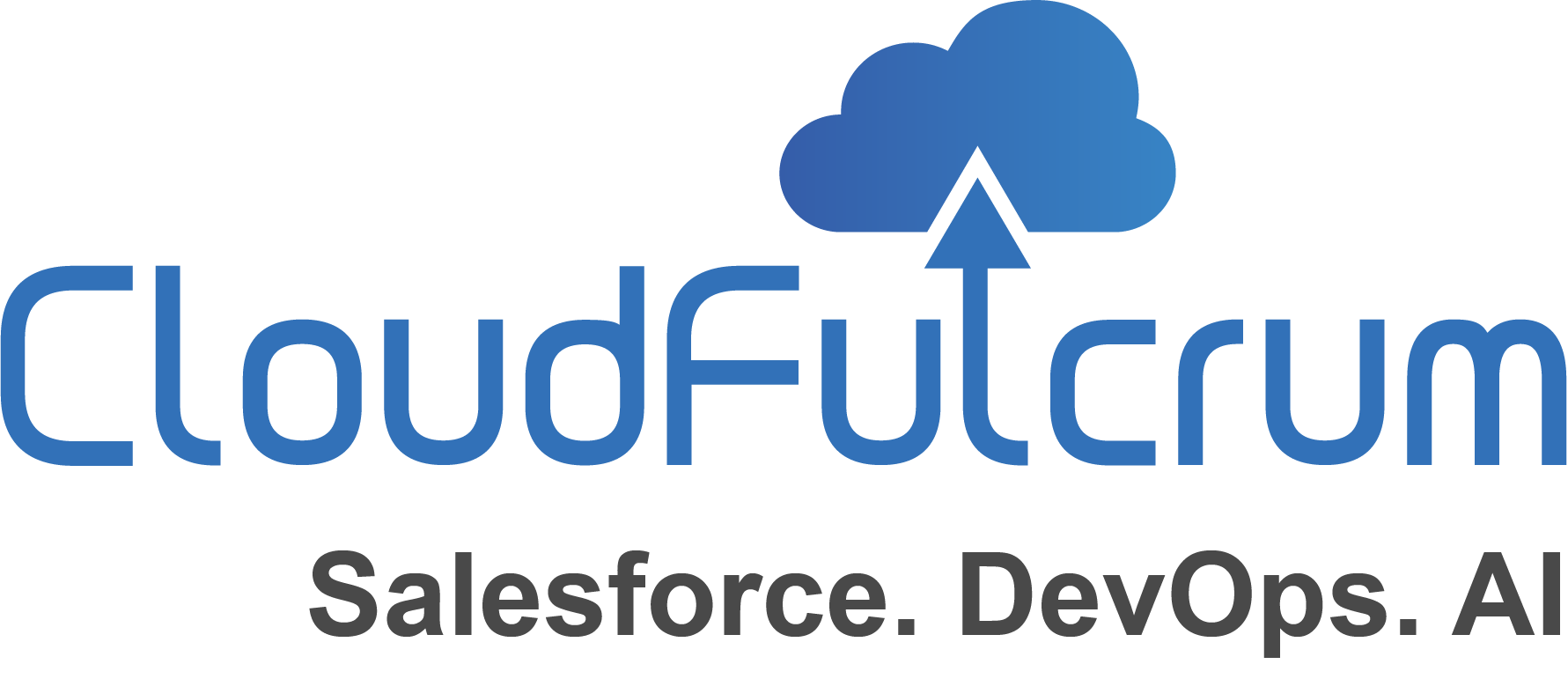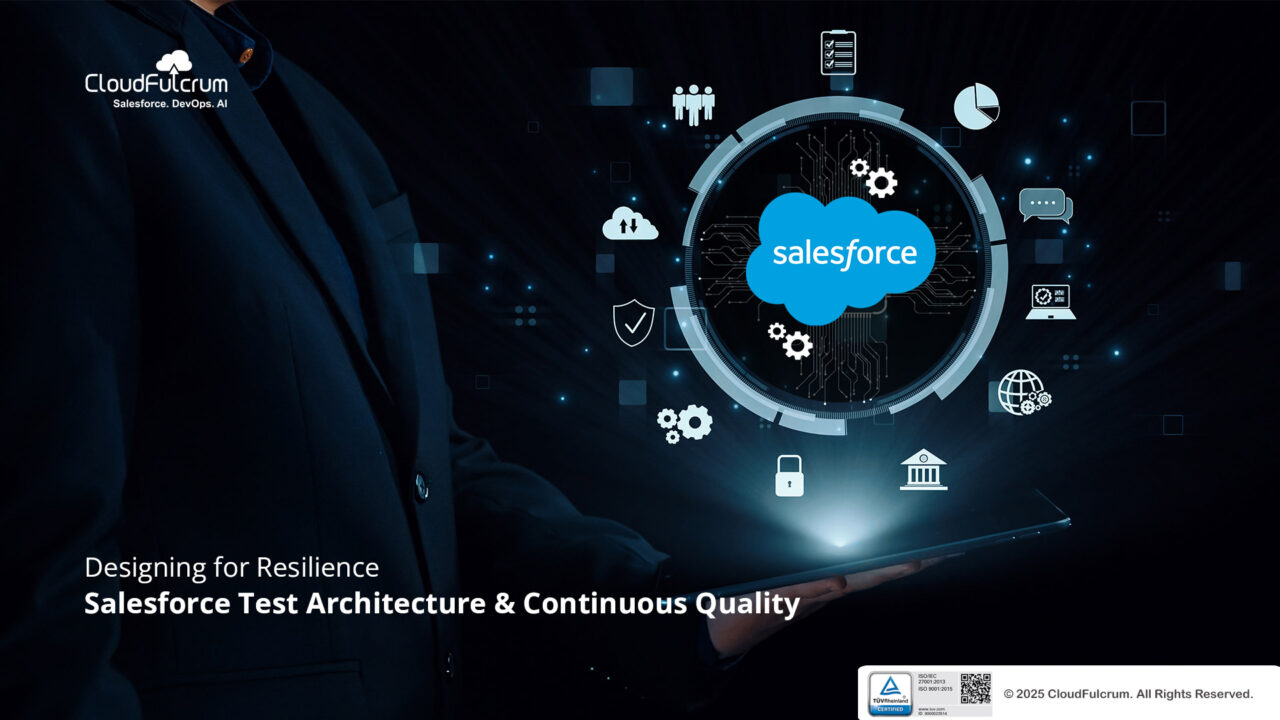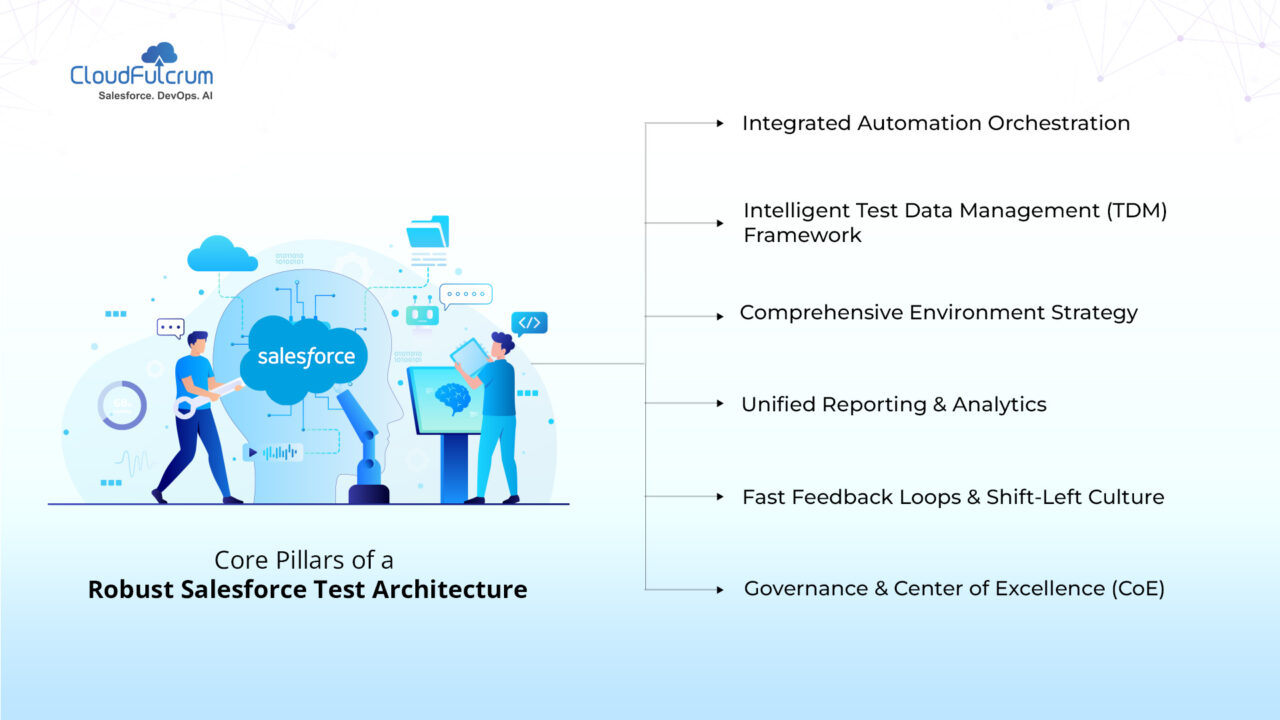Our journey through “Mastering Salesforce Quality” has been a comprehensive exploration. We began by establishing the non-negotiable imperative of structured testing (Blog 1), then laid the foundational practices (Blog 2). We unveiled the compelling ROI of automation (Blog 3), dove into its best practices and tools (Blog 4), and tackled the critical “Data Dilemma” of Test Data Management (Blog 5). Now, in this final, culminating post, we bring all these threads together.
The ultimate goal isn’t just to do testing, but to design for continuous quality—to build a Salesforce environment that is inherently resilient, adapts seamlessly to change, and consistently delivers value with speed and confidence. This requires a well-conceived Salesforce Test Architecture: a strategic blueprint that integrates people, processes, tools, and environments into a cohesive, high-performing system.
At CloudFulcrum, we believe that robust quality is the bedrock of innovation, not a barrier to it. This article will define what a modern Salesforce Test Architecture entails, highlight its core pillars, and demonstrate how it fosters true continuous quality. Finally, we’ll position CloudFulcrum as your trusted partner in navigating this complex landscape, offering a clear call to action to help you transform your Salesforce quality journey.
The Grand Synthesis: What is Salesforce Test Architecture?
A Salesforce Test Architecture is more than just a collection of tools; it’s the integrated system that orchestrates every aspect of your quality assurance efforts across the Salesforce development and release lifecycle. It’s the framework that ensures your investments in structured testing, automation, and data management work in harmony, maximizing their collective impact.
Its primary purpose is to build resilience. In the context of Salesforce, resilience means:
- Ability to Withstand Change: Your customizations, integrations, and business processes remain stable and functional through frequent Salesforce releases and continuous internal deployments.
- Adaptability: Your testing efforts can quickly pivot to validate new features, evolving business requirements, and emerging technologies.
- Consistent Delivery: High-quality solutions are delivered predictably, on time, and without critical defects.
This architecture fundamentally enables Continuous Quality – a mindset and practice where quality isn’t a final checkpoint, but an ongoing, embedded responsibility of every team member throughout the entire DevOps pipeline.
Core Pillars of a Robust Salesforce Test Architecture
Building a resilient Salesforce Test Architecture involves strategically connecting several vital components:
- Integrated Automation Orchestration:
- The Concept: Your automated test suites (as discussed in Blog 4) aren’t run in isolation. They are seamlessly integrated into your Continuous Integration/Continuous Delivery (CI/CD) pipeline.
- How it Works: Every code commit, every configuration change, or every new build automatically triggers relevant test suites. This immediate feedback loop is critical.
- Salesforce Relevance: Modern Salesforce DevOps platforms (like Copado, Gearset, AutoRABIT) or general CI/CD tools (like Jenkins, GitLab CI, Azure DevOps) provide the necessary connectors and orchestration capabilities to run Apex tests, UI automation, and API tests as part of your automated deployment process. This ensures quality gates are met before changes progress to the next environment.
- Intelligent Test Data Management (TDM) Framework:
- The Concept: The robust TDM strategies from Blog 5 are not isolated practices but are deeply embedded within your architecture.
- How it Works: The architecture defines how production data is masked and seeded, how synthetic data is generated on demand, and how test environments are provisioned with the right data for specific test runs.
- Salesforce Relevance: Integration with Salesforce Data Mask, specialized TDM tools, or custom Apex/automation scripts ensures that every test run, whether manual or automated, has access to reliable, secure, and relevant data without manual intervention or compliance risk.
- Comprehensive Environment Strategy:
- The Concept: Beyond simply having sandboxes, the architecture defines a clear purpose, management, and automated provisioning strategy for each environment in your pipeline.
- How it Works: This includes clear guidelines for when to use Developer, Partial Copy, or Full Copy sandboxes; automated refresh mechanisms; and procedures for deploying specific metadata and data to ensure consistency across environments.
- Salesforce Relevance: A well-defined environment strategy prevents “it worked on my machine” scenarios, ensures production-like testing conditions, and streamlines the path to deployment by reducing environmental inconsistencies.
- Unified Reporting & Analytics:
- The Concept: All test results, regardless of whether they come from manual execution, Apex unit tests, or UI automation, are aggregated into a centralized reporting system.
- How it Works: Dashboards provide real-time visibility into test progress, pass/fail rates, code coverage, defect trends, and overall quality health.
- Salesforce Relevance: This provides actionable insights for developers, admins, QA, and business stakeholders, enabling informed decisions, early risk identification, and continuous improvement of both the application and the testing process itself.
- Fast Feedback Loops & Shift-Left Culture:
- The Concept: The architecture is designed to provide rapid feedback to everyone involved in the Salesforce delivery process, pushing quality “left” (earlier) in the development lifecycle.
- How it Works: Automated tests run immediately after a change, notifying developers if they’ve introduced a regression. Collaborative tools facilitate quick communication between Dev, Admin, QA, and Business.
- Salesforce Relevance: This minimizes the time and cost of fixing defects, fosters a culture where quality is a shared responsibility, and allows teams to iterate quickly with confidence.
- Governance & Center of Excellence (CoE):
- The Concept: Establishing clear standards, best practices, and ownership for the testing architecture.
- How it Works: A Salesforce QA Center of Excellence (CoE) often leads this, defining tool chains, training paths, test design principles, and ensuring consistent application of the quality framework across the organization.
- Salesforce Relevance: Given Salesforce’s distributed administration model in many companies, a CoE ensures consistency, reusability, and continuous improvement of quality practices, preventing silos and ad-hoc approaches.
The Promise of Continuous Quality: Beyond Go-Live
With a robust Salesforce Test Architecture in place, quality ceases to be a frantic scramble before each go-live and transforms into a continuous, ingrained discipline. This means:
- Agile Innovation: Your teams can deploy new features and enhancements more frequently and reliably, accelerating your time-to-market.
- Reduced Risk: The likelihood of critical defects reaching production is significantly minimized, protecting your revenue, reputation, and customer satisfaction.
- Operational Efficiency: Less time spent firefighting production issues means more time dedicated to strategic initiatives and innovation.
- Enhanced Trust: Users gain confidence in the stability and reliability of the Salesforce platform, leading to higher adoption and productivity.
- Future-Proofing: Your quality processes are designed to adapt to Salesforce’s frequent releases and the evolving needs of your business.
CloudFulcrum: Your Partner in Architecting Salesforce Quality Excellence
Building a comprehensive, resilient Salesforce Test Architecture can seem like a monumental undertaking. It requires deep expertise not only in Salesforce itself but also in quality assurance methodologies, automation frameworks, DevOps principles, and intricate data management strategies.
At CloudFulcrum, we don’t just understand Salesforce; we live and breathe its complexities. Our deep expertise in platform nuances, coupled with years of delivering robust quality solutions across diverse industries, positions us uniquely to guide your organization through this transformative journey. We see quality not as a bottleneck, but as a powerful accelerator for your business.
Our seasoned team of Salesforce QA specialists, automation engineers, and TDM experts work hand-in-hand with your administrators, developers, and business stakeholders to design, implement, and optimize a Salesforce test architecture that truly aligns with your unique business goals and technical landscape. From strategic planning and tool selection to implementation and ongoing support, CloudFulcrum provides end-to-end services to empower your Salesforce testing capabilities and drive continuous quality.
Take the Next Step: Unlock Your Salesforce Quality Potential with a Strategic Assessment
Are you ready to transform your Salesforce quality from a constant challenge into a profound competitive advantage? Don’t let the complexity or uncertainty slow you down.
CloudFulcrum offers a specialized Salesforce Quality & Testing Maturity Assessment. This comprehensive assessment will provide:
- A current state analysis of your existing Salesforce testing practices, tools, environments, and processes.
- Identification of key bottlenecks, risks, and areas of inefficiency.
- A tailored roadmap with actionable, prioritized recommendations for achieving your desired quality maturity level.
- Expert insights into best-fit tools and strategies uniquely suited for your Salesforce organization and business objectives.
Contact CloudFulcrum today to schedule your complimentary Salesforce Quality & Testing Maturity Assessment. Let’s collaborate to build a resilient, high-performing Salesforce future that truly empowers your business for continuous success.


